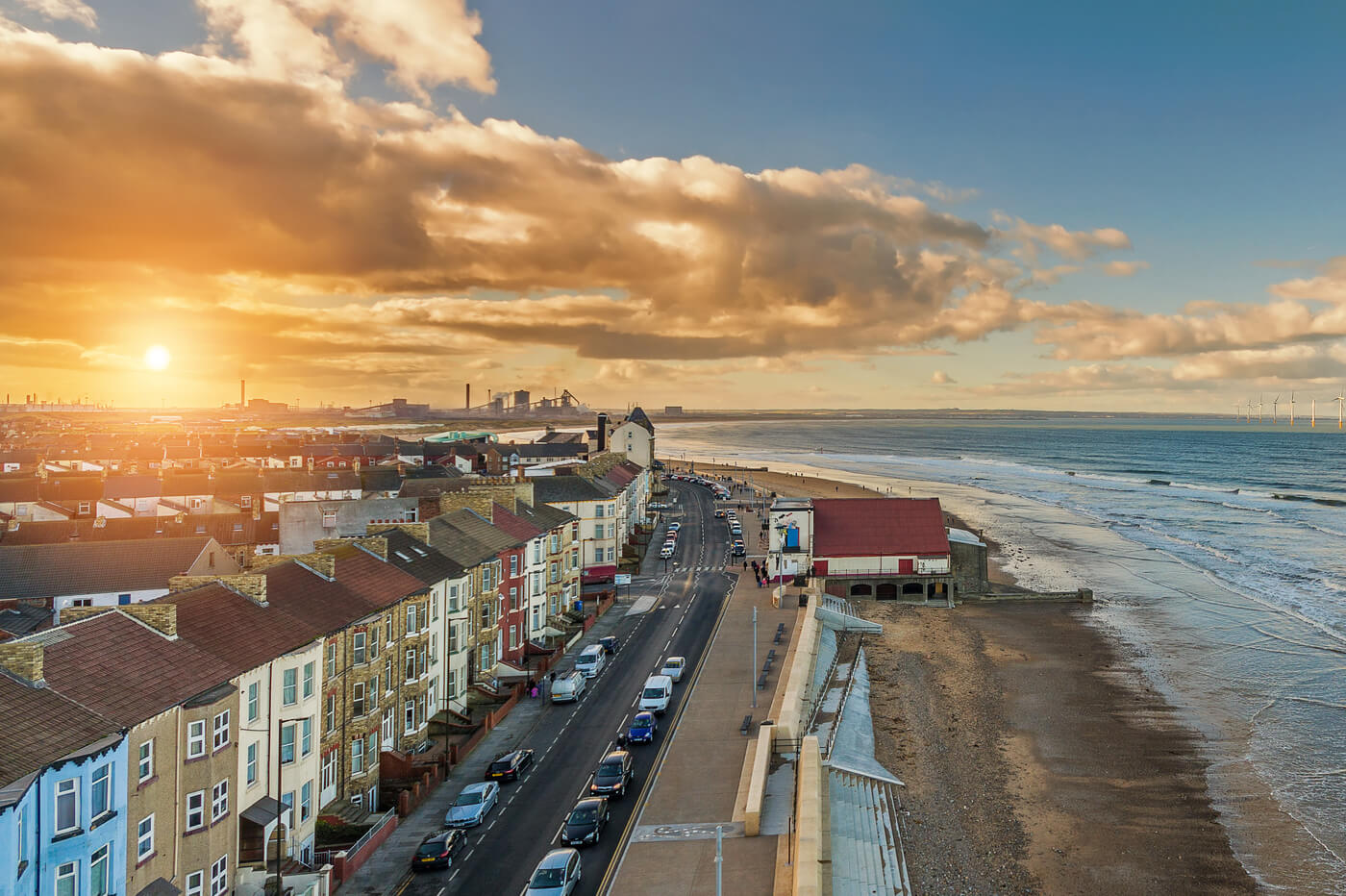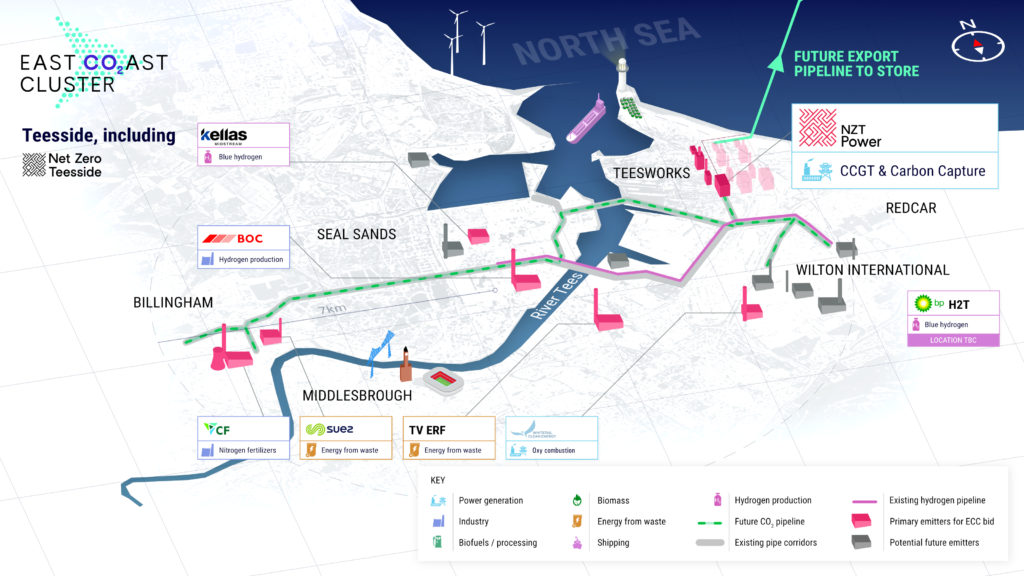 Downtown Redcar situated in the Tees Valley
Downtown Redcar situated in the Tees Valley
Introduction
This article will not hail the promises of hydrogen or carbon capture in the worship of technical superiority. Nor will it lampoon the deleterious effects of corporate greenwashing through searing harassment. In fact, it is much less an article of inducement on the market forces of the future, but the unfolding story of a coastal town buffeted by the winds of global change.
Situated 220 miles northeast of London on the blustery coast of England, one can find the roughly 40,000-person town of Redcar. With origins as far back as the Old Norse, obligatory fish and chip shops, and sandy beaches reminiscent of the quintessential coastal retreat, Redcar offers a relaxing weekend away from the stresses of modernity. A stroll along the beach provides a refreshing tang of salty breeze while also a glimpse at the future of industrial development.
Up until recently, the skyline of Redcar was dominated by the hulking megastructure which was Redcar Steelworks. Once the second-largest blast furnace in Europe, the agglomeration initially founded by British Steel directly supported 2,200 jobs over the past century. After a spat of consecutive owners unable to rejuvenate the plant, the once omnipresent structure now only exists wistfully in the memory of past denizens. Aided by an £80m government fund set up in the aftermath of the plant’s closure, past workers have been able to move on. Years later, the now-vacant lot hopes for its own second chance at redevelopment.
 A view of the now-demolished Redcar Steelworks from the neighboring Redcar town
A view of the now-demolished Redcar Steelworks from the neighboring Redcar town
Teeswork
Christened as Teeswork, the 4,500-acre industrial park seeks to capitalize on the sustainability bonanza being felt around the globe while revitalizing past sites such as Redcar Steelworks. Already the largest brownfield area in Europe, the sprawling mélange offers plenty of space for what locals hope to be a green bullet against the retreat of historically entrenched carbon-intensive industries. So far, a confluence of three critical factors ranging from natural location, political cohesion, and global technological trends has fortuitously provided the region with a fighting chance for redevelopment and a missive for observers around the globe. First, start with where Redcar is located.
Facing the North Sea, the region is home to Teesport. The 5th largest port in the UK and the only major entrepôt to handle more exports than imports, Redcar finds itself embedded into international trade through maritime activity. This facet proffers ready access to European and global markets, and as such, has contributed to seeding the surrounding Tees valley with a manifold of chemical, petrochemical, and steel processing industries.
In addition, Teeside has served as a natural gas production hub for giants such as Total and BP which operate in the British North Sea, and currently is one of only six ports in the world set up for the import and export of ammonia (a favorable characteristic due to the rising interest in green ammonia).
This rich historical legacy of varied industrial development has also beneficially led to a diverse economy and workforce primed for manufacturing investments (which has often been critical in staving off boom and bust workforce cycles compared to single industry-dominated towns). Due to the geographical conditions and past industrial might, there is an increasingly clear reason for investors’ excitement.
The second advantage Redcar holds is the accelerating metamorphosis of local policy and national initiatives with the aim of generating green-collar jobs. As mentioned, Teeswork already has a central logistics hub in the form of Teesport which is also included in the newly minted government freeport zones pushing to reduce international trade barriers. Now, it has a political force aiming for green investment. Locally led by mayor Ben Houchen and a consortium of industry players, Net Zero Teeside is one link in the ambitious EAST CO2AST CLUSTER aiming to decarbonize 50% of the UK’s industrial emissions through carbon capture technologies and green fuel developments.
 The EAST CO2AST CLUSTER initiative centered around two hubs, one of which is Teeside. The project hopes to remove up to 50% of the UK’s industrial emissions while revitalizing the industrial heartland of England.
The EAST CO2AST CLUSTER initiative centered around two hubs, one of which is Teeside. The project hopes to remove up to 50% of the UK’s industrial emissions while revitalizing the industrial heartland of England.
So far, the political effort has been announced as one of the two priority clusters in the UK Governments Carbon Capture, Usage and Storage (CCUS) cluster sequencing process (which aims to establish the first net zero-carbon industrial cluster by 2040 through targeted funding and backed government support). In Redcar specifically, The Net Zero Teesside project is to be powered by the world’s first commercial-scale carbon capture gas-fired power station with pipelines to depleted offshore gas sites for CO2 storage.
The promises of politically driven decarbonized energy and convenient carbon offtakes seek to attract industrial investments while also enabling hard to decarbonize industries a pathway not only to environmental, but increasingly financial and political sustainability. As indicated by Mayor Houchem, “Investing in the clean industries of the future is not just important in achieving net-zero, it’s also crucial for jobs.”
Third and finally, the current period of rapid global technology advancements bundled with overarching international policy initiatives provides feasibility to cities such as Redcar’s objectives. In today’s sustainability proclamations and international energy security concerns, there is a ubiquitous urge to act for fear of being left out. The environment around Redcar is none the exception.
Take for example three recent announcements. At Teeswork, GE Renewable Energy has announced plans for a wind turbine manufacturing site in anticipation of servicing the upcoming Dogger Bank wind farm (which seeks to claim the title of the largest wind farm in the world). BP is looking to build both blue and green hydrogen plants for fueling the surrounding region’s industrial plants. And Tees Lithium Valley looks to replicate Tesla’s gigafactory expansion with one plant alone to meet roughly 15% of the demand forecast across the EU and Great Britain by mid-decade for lithium hydroxide in EV batteries (see below image for more company developments).
 Visualization of the diverse industrial developments announced in the Tees Valley in the Net Zero Teeside program.
Visualization of the diverse industrial developments announced in the Tees Valley in the Net Zero Teeside program.
The projects mentioned above rely on technology that decades ago was in its infancy, yet is now increasingly mature. Due to the multi-decadal effort of countries’ renewable cost reductions, Redcar is now wielding apt tools to progress in rapid decarbonization at an industrial scale. With low-cost renewable energy, falling electrolyzer, battery, and carbon capture and sequestration costs, and energy security concerns combined with supply chain upheaval, once unattainable goals appear tantalizing real.
While Redcar sits on a green opportunity for industrial diversification in the foreseeable future, the question emerges of what makes Redcar unique. Pundits will be quick to point out that Teesport links together markets thus spawning industries ripe for export. Others will hail the ingenuity of British policy bringing jobs home in an age rife with uncertainty. A third group will wag their finger in nonchalance claiming only global trends have enabled company green treatises to roll out.
In fact, when all three of these attributes merge together we see the creation of hopeful potential in the name of green development. Yet as all too clear from recent travails, it is at best foolish to predict the success of any long-term investment in today’s day and age. However, there are essential characteristics that can be explicated from the promising region.
First, the continued focus on sustainability initiatives increases the propensity for co-locating once disparate industries in naturally favorable locations. Second, local and national initiatives in partnership with the private sector’s drive for financial sustainability through funding competitions provide one option for enacting system-wide change. Third, a cyclone of green corporate proclamations and technological innovations is already here, leaders should be careful not to be swept away from less glitzy solutions such as energy efficiency programs via local partnerships.
It is worth noting the risks associated with the development of such sustainability hubs. While investment prospers in anointed locations, it is still uncertain whether the local benefits outweigh the consequences of divestment from other cities and towns across the country. The creation of new green manufacturing centers also probes towards a deeper debate on how climate change should be approached.
Technocrats posit developments such as the EAST CO2AST CLUSTER as logical solutions to current day demands without laymen interaction. However, the advancement of such technological jewels must be bolstered by sustainable community development if lasting change is to take hold. As pertinently stated by Robert Swan-the first person to walk both the North and South Poles and environmental activist-“the greatest threat to our planet is the belief that someone else will save it.”
The oldest lifeboat in the world (the Zetland) now resides in Redcar. Built by Henry Greathead in 1802, he also made 31 of the world’s first lifeboats. Two centuries later, Redcar hopes again to build a vehicle for change, rescuing not only locals from unemployment but the greater environment from global catastrophe. It might be time to repurpose their lifeboat with a rudder and sails as from all current signs, the winds are in their favor for now.
 The world's oldest lifeboat the Zetland in Redcar. Now might be a good time to repurpose it...
The world's oldest lifeboat the Zetland in Redcar. Now might be a good time to repurpose it...